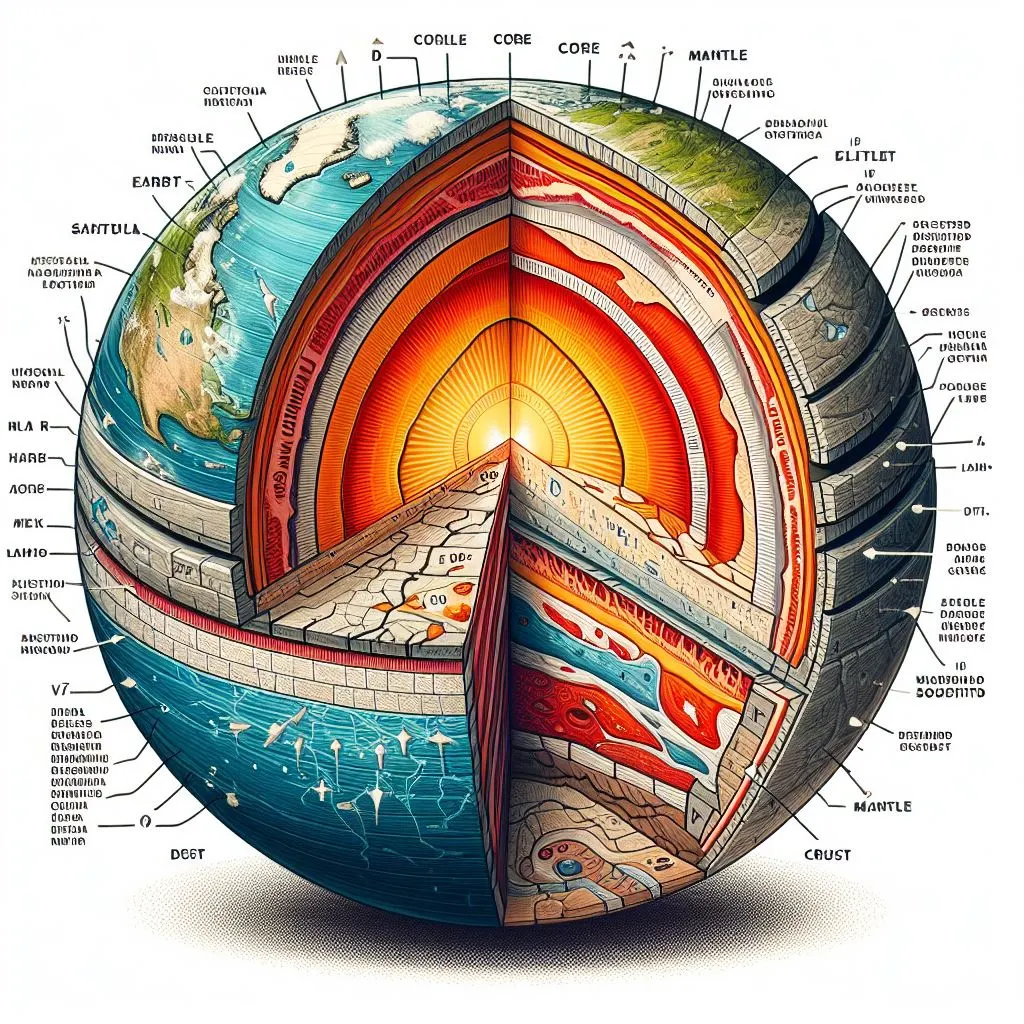Class 11th Geography Chapter 3 Objective Question Answer, class 11 geography chapter 3 objective question,class 11 geography chapter 3 objective questions,class 11 geography objective questions,class 11th geography chapter 3,#class 11th geography chapter – 3,#11th class chapter 3 geography mcq,class 11th geography chapter 3 question answer,class 11 geography objective question 2024,ncert geography class 11 chapter 3,class 11 geography objective questions in hindi,geography class 11 chapter 3 objective question answerr
पृथ्वी की आंतरिक संरचना [Earth's internal structure.]
Class 11th Geography Chapter 3
● सही विकल्प का चयन करें-
Q. ‘P’ व ‘S’ तरंगों के छाया क्षेत्र का अधि केन्द्र से विस्तार है-
(Shadow zone of ‘P’ and ‘S’ waves expand from epicentre )
(a) 135-175°
(b) 125-165°
(c) 115-155°
(d) 105-145°
Q. निम्नलिखित में से कौन-सा तथ्य पृथ्वी की आंतरिक बनावट पर सर्वाधिक प्रकाश डालता है ?
(Which Factor largly indicates about the interior of the earth ? )
(a) ज्वालामुखी उद्भेदन (Volcanic erruption)
(b) भूकम्पीय तरंगें (Seismic waves)
(c) कुओं का खोदा जाना (To dig wells)
(d) गहरी खदानों को खोदा जाना (To dig deep mines)
Q. पृथ्वी के भीतरी भाग में तापमान की वृद्धि की औसत दर क्या है ?
(What is the average increasing rate of temperature inside the earth ? )
(a) 10°C प्रति 100 मीटर
(b) 1°C प्रति 32 मीटर
(c) 12°C प्रति किमी
(d) 1°C प्रति किमी
Q. गुटेनवर्ग अंसान्तत्यता पायी जाती है ?
(Guttenberg Discontinuity is found )
(a) ऊपरी क्रस्ट व निचला क्रस्ट के बीच (between lower crust and
upper crust)
(b) निचला मैण्टल व ऊपरी क्रोड के बीच (between Lower Mantte and upper core)
(c) निचला क्रस्ट व ऊपरी मैण्टल के बीच (between lower crust and upper mentle)
(d) कोई नहीं (None of these)
Q. पृथ्वी की अभ्यांतर परत को क्या कहा जाता है ?
(The certral part core of the earth is called )
(a) मैटल (Mantle)
(b) नीफे (Nife)
(c) सीमा (Sima)
(d) सियाल (Sial)
Q. निम्नलिखित में से कौन-सी भूकम्पीय तरंगें पृथ्वी के क्रोड में गुजर सकती हैं ?
(Which earthquake waves can penetrate the core ? )
(a) कोई भी नहीं (None of these)
(b) एल तरंगें (‘L’ wares)
(c) एस तरंगें (‘S’ wares)
(d) पी तरंगें (‘P’ wares)
Q. पृथ्वी की आन्तरिक संरचना को सियाल, सीमा व नीफे में किसने वर्गीकृत किया ?
(Who classified the interior of the earth as sial, Sima and Nife ? )
(a) कोबर ने (Cober)
(b) स्वेस ने (E.Suess)
(c) होम्स ने (Holmes)
(d) डटन ने (Dutton)
Q. दक्षिणी अफ्रीका की सोने की खानें कितनी गहरी हैं ?
(What is the depth of gold mines of Africa ? )
(a) 6-7 किमी (6-7 km)
(b) 5-6 किमी (5-6 km)
(c) 4-5 किमी (4-5 km)
(d) 3-4 किमी (3-4 km)
Q. भूपर्पटी में विकसित थरथराहट को कहते हैं ?
(The sudden vibrations or tremor of crust is called )
(a) पृथ्वी का घूर्णन (Rotation of earth)
(b) भूकम्प (Earthquake)
(c) पृथ्वी की गति (Motion of earth)
(d) भूसंचरण (Earthmovement)
Q. पृथ्वी की त्रिज्या कितनी है ?
(The Diametre of earth is )
(a) 8370 किमी (8370 km)
(b) 7370 किमी (7370 km)
(c) 6370 किमी (6370 km)
(d) 5370 किमी (5370 km)
Q. कौन-सी भूकम्पीय तरंगें भूक्रोड में प्रवेश नहीं कर पाती और वक्राकार मुड़ जाती हैं ?
(Which seismic waves does not penetrate the core and slightley bent or do not enter in liquid portion beneath the earth ? )
(a) धरातलीय तरंगें (‘L’ Waves)
(b) प्राथमिक तरंगें (‘P’ Waves)
(c) गौण तरंगें (‘S’ Waves)
(d) कोई नहीं
Q. पृथ्वी के क्रोड पर कौन-से दो पदार्थ पाये जाते हैं ?
(Which two matters are found on the earth’s core ? )
(a) लोहा तथा चूना
(b) निकिल तथा लोहा
(c) ताँबा तथा लोहा
(d) निकिल तथा ताँबा
Q. सम्पूर्ण पृथ्वी का घनत्व है-
(a) 11
(b) 5.5
(c) 3.5
(d) 2.5
Q. निम्न में भूकम्प तरंगें चट्टानों में संकुचन व फैलाव लाती है-
(Which earthquake waves bring expansion and reduction in rocks ? )
(a) ‘p’ तरंगें (‘p wave’)
(b) ‘L’ तरंगे (‘L’ wave)
(c) ‘s’ तरंगें (‘s’ wave)
(d) उपर्युक्त में से कोई नहीं
Q. पृथ्वी की किस परत में बेसाल्ट चट्टानें पाई जाती है ?
(In which layers of earth Besalt rocks are found ? )
(a) सीमा (Sima)
(b) निफे (Nife)
(c) सियाल (Sial)
(d) किसी में नहीं
Q. भू-पृष्ठ का घनत्व बताओ-
(Density of crust is )
(a) 5.53
(b) 2.75
(c) 5.68
(d) 17.2
Q. अभ्यांतर में अधिकतम घनत्व का मुख्य कारण क्या है ?
(What is the reason of Maximum density of (core) central part of earth ? )
(a) निकल तथा लौह धातुएँ (Nickel and Iron minerals)
(b) तरल पदार्थ (Liquid Material)
(c) अधिक तापमान (More temperature)
(d) अधिक गहराई (Maximum Depth)
Q. भूकम्पों के कारण समुद्रों में विकसित विशाल तरंगें होती है ?
(Lange oceanic waves caused by Earthquake is called)
(a) धरातलीय तरंगे (Surface waves)
(b) सुनामी तरंगें (Tsunami waves)
(c) ज्वारीय तरंगें (Tidal waves)
(d) समुद्री तरंगें (Ocean waves)
Q. निम्नलिखित में से पृथ्वी के किस भाग में घनत्व सर्वाधिक है ?
(a) आंतरिक क्रोड (Internal Core)
(b) बाह्य क्रोड (External Core)
(c)मॅटल (Mental)
(d) पर्पटी (Crust)
Q. प्रकृतिक भूकम्प किस भू-भाग में आते हैं ?
(Natural Earthquake occurs in)
(a) क्रोड (Core)
(b) नाईफ (Nife)
(c) मैटल (Mantle)
(d) स्थल खण्ड (Crust)
Q. कौन-सी भूकम्पीय तरंगें पृथ्वी से 2900 किलोमीटर की गहराई के पश्चात् लुप्त हो जाती हैं ?
(Which earthquake waves (seismic waves) disappear below the depth of 2900 km ? )
(a) अनुदैर्ध्य (Longitudinal)
(b) धरातलीय (Surface ‘L’ waves)
(c) गौण (Secondary ‘S’ waves)
(d) प्राथमिक (Primary (‘P’ waves)
Q. निम्नलिखित में से पृथ्वी की संरचना का मुख्य स्रोत क्या है ?
(Which is the major source of interior of earth? )
(a) पृथ्वी का घनत्व (Dinsity of earth)
(b) पृथ्वी का तापमान (Temperature of earth)
(c) ज्वालामुखी (Volcanaes)
(d) भूकम्पीय तरंगें (Earthquake waves)
Q. दक्कन ट्रैप की शैल समूह किस प्रकार के ज्वालामुखी उद्गार का परिणाम है ?
(What type of volcanic erruption is of rock group of Daccan trap ? )
(a) कुण्ड (Tank)
(b) प्रवाह (Flow)
(c) शील्ड (Shield)
(d) मिश्र (Composite)
Q. पृथ्वी की आन्तरिक परत निफे के निर्माण में किन तत्वों की प्रधानता है ?
(Which alloy are found in nife in the inner central past of earth ? )
(a) निकिल एवं लोहा (Nickel and Iron
(b) बेसाल्ट व सिलिका (Besalt and Silica)
(c) सिलिका व मैग्नीशियम (Silic and magnesium)
(d) सिलिका व ऐलुमिनियम (Silica and aluminium)
Q. पृथ्वी में किस गहराई पर तापमान बढ़ने से ठोस पदार्थ तरलावस्था में आ जाते हैं ?
(At which depth inside the earth solid rocks and minerals turn into liquid form ? )
(a) 10 किलोमीटर (10 km)
(b) 96 किलोमीटर (96 km)
(c) 50 किलोमीटर (50 km)
(d) 32 किलोमीटर (32 km)
Q. भूक्रोड का घनत्व है
(The Density of Core is)
(a) 17 से अधिक (more than 17)
(b) 11 से 13.6 (11 to 13.6)
(c) 8 से 11 (8 to 11)
(d) 5 से 7 (5 to 7)
Q. निम्नलिखित में से कौन-सा स्थलमण्डल को वर्णित करता है ?
(Which describes Lithesphere )
(a) मॅटल व क्रोड (Mantle and core)
(b) भूपटल व क्रोड (Crust and Core)
(c) भूपटल व ऊपरी मँटल (Crust and upper Mantle)
(d) ऊपरी व निचले मँटल (Upper and lower mantle)
Q. मोहोअंसम्बधता की खोज कब व किसने की ?
(Who and when discovered Moho-discontinuty ? )
(a) 1901, Gutenberg
(b) 1903 Wegner
(c) 1902 Mohorovicic
(d) None of these
Q. भूकम्पीय तरंगों को रेखांकित करने वाला यंत्र-
(Which instrument measures the seismic waves ? )
(a) बैरोग्राफ (Berograph)
(b) हाइग्रोग्राफ (Hygrograph)
(c) सिस्मोग्राफ (Seismograph)
(d) थर्मोग्राफ (Thermograph
Q. मोहो-अंसम्बधता पायी जाती है-
(Moho-discontinyity is found )
(a) ऊपरी क्रस्ट व निचली क्रस्ट के बीच (In the middle of upper curst and lower crust)
(b) निचला भूपटल व ऊपरी मैण्टल के बीच (between lower crust and upper mantle)
(c) मैण्टल व कोर के बीच (between Mantle and core)
(d) कोई नहीं (None of these)
Q. भूकम्प की तीव्रता का माप किस वैज्ञानिक के नाम पर है ?
(Which scientist measure the intesity of earthquake ? )
(a) ऑटो शिमिड (Otto Schimdt)
(b) मरकैली (Mercalli)
(c) लाप्लेस (Laplace)
(d) कांट (Kant)
Q. निम्नलिखित में से कौन-सा भूगर्भ की जानकारी का प्रत्यक्ष साधन है ?
(Which one of the following is the direct means of giving knowledge of interior of the earth ? )
(a) उल्काएँ (Meteors)
(b) गुरुत्वाकर्षण (Graritation)
(c) ज्वालामुखी (Volcanoes)
(d) भूकम्पीय तरंगें (Earthquake wares)






![{"type":"elementor","siteurl":"https://studywithyogi.com/wp-json/","elements":[{"id":"a6467ba","elType":"widget","isInner":false,"isLocked":false,"settings":{"text":"Youtube","link":{"url":"https://www.youtube.com/channel/UCPlglWIxgFJmmMFRE0987_w","is_external":"","nofollow":"","custom_attributes":""},"align":"center","button_type":"","size":"sm","selected_icon":{"value":"","library":""},"icon_align":"left","icon_indent":{"unit":"px","size":"","sizes":[]},"button_css_id":"","align_tablet":"","align_mobile":"","typography_typography":"","typography_font_family":"","typography_font_size":{"unit":"px","size":"","sizes":[]},"typography_font_size_tablet":{"unit":"px","size":"","sizes":[]},"typography_font_size_mobile":{"unit":"px","size":"","sizes":[]},"typography_font_weight":"","typography_text_transform":"","typography_font_style":"","typography_text_decoration":"","typography_line_height":{"unit":"px","size":"","sizes":[]},"typography_line_height_tablet":{"unit":"em","size":"","sizes":[]},"typography_line_height_mobile":{"unit":"em","size":"","sizes":[]},"typography_letter_spacing":{"unit":"px","size":"","sizes":[]},"typography_letter_spacing_tablet":{"unit":"px","size":"","sizes":[]},"typography_letter_spacing_mobile":{"unit":"px","size":"","sizes":[]},"typography_word_spacing":{"unit":"px","size":"","sizes":[]},"typography_word_spacing_tablet":{"unit":"em","size":"","sizes":[]},"typography_word_spacing_mobile":{"unit":"em","size":"","sizes":[]},"text_shadow_text_shadow_type":"","text_shadow_text_shadow":{"horizontal":0,"vertical":0,"blur":10,"color":"rgba(0,0,0,0.3)"},"button_text_color":"","background_background":"classic","background_color":"","background_color_stop":{"unit":"%","size":0,"sizes":[]},"background_color_stop_tablet":{"unit":"%"},"background_color_stop_mobile":{"unit":"%"},"background_color_b":"#f2295b","background_color_b_stop":{"unit":"%","size":100,"sizes":[]},"background_color_b_stop_tablet":{"unit":"%"},"background_color_b_stop_mobile":{"unit":"%"},"background_gradient_type":"linear","background_gradient_angle":{"unit":"deg","size":180,"sizes":[]},"background_gradient_angle_tablet":{"unit":"deg"},"background_gradient_angle_mobile":{"unit":"deg"},"background_gradient_position":"center center","background_gradient_position_tablet":"","background_gradient_position_mobile":"","background_position":"","background_position_tablet":"","background_position_mobile":"","background_xpos":{"unit":"px","size":0,"sizes":[]},"background_xpos_tablet":{"unit":"px","size":0,"sizes":[]},"background_xpos_mobile":{"unit":"px","size":0,"sizes":[]},"background_ypos":{"unit":"px","size":0,"sizes":[]},"background_ypos_tablet":{"unit":"px","size":0,"sizes":[]},"background_ypos_mobile":{"unit":"px","size":0,"sizes":[]},"background_attachment":"","background_repeat":"","background_repeat_tablet":"","background_repeat_mobile":"","background_size":"","background_size_tablet":"","background_size_mobile":"","background_bg_width":{"unit":"%","size":100,"sizes":[]},"background_bg_width_tablet":{"unit":"px","size":"","sizes":[]},"background_bg_width_mobile":{"unit":"px","size":"","sizes":[]},"background_video_link":"","background_video_start":"","background_video_end":"","background_play_once":"","background_play_on_mobile":"","background_privacy_mode":"","background_video_fallback":{"url":"","id":"","size":""},"background_slideshow_gallery":[],"background_slideshow_loop":"yes","background_slideshow_slide_duration":5000,"background_slideshow_slide_transition":"fade","background_slideshow_transition_duration":500,"background_slideshow_background_size":"","background_slideshow_background_size_tablet":"","background_slideshow_background_size_mobile":"","background_slideshow_background_position":"","background_slideshow_background_position_tablet":"","background_slideshow_background_position_mobile":"","background_slideshow_lazyload":"","background_slideshow_ken_burns":"","background_slideshow_ken_burns_zoom_direction":"in","hover_color":"","button_background_hover_background":"classic","button_background_hover_color":"","button_background_hover_color_stop":{"unit":"%","size":0,"sizes":[]},"button_background_hover_color_stop_tablet":{"unit":"%"},"button_background_hover_color_stop_mobile":{"unit":"%"},"button_background_hover_color_b":"#f2295b","button_background_hover_color_b_stop":{"unit":"%","size":100,"sizes":[]},"button_background_hover_color_b_stop_tablet":{"unit":"%"},"button_background_hover_color_b_stop_mobile":{"unit":"%"},"button_background_hover_gradient_type":"linear","button_background_hover_gradient_angle":{"unit":"deg","size":180,"sizes":[]},"button_background_hover_gradient_angle_tablet":{"unit":"deg"},"button_background_hover_gradient_angle_mobile":{"unit":"deg"},"button_background_hover_gradient_position":"center center","button_background_hover_gradient_position_tablet":"","button_background_hover_gradient_position_mobile":"","button_background_hover_position":"","button_background_hover_position_tablet":"","button_background_hover_position_mobile":"","button_background_hover_xpos":{"unit":"px","size":0,"sizes":[]},"button_background_hover_xpos_tablet":{"unit":"px","size":0,"sizes":[]},"button_background_hover_xpos_mobile":{"unit":"px","size":0,"sizes":[]},"button_background_hover_ypos":{"unit":"px","size":0,"sizes":[]},"button_background_hover_ypos_tablet":{"unit":"px","size":0,"sizes":[]},"button_background_hover_ypos_mobile":{"unit":"px","size":0,"sizes":[]},"button_background_hover_attachment":"","button_background_hover_repeat":"","button_background_hover_repeat_tablet":"","button_background_hover_repeat_mobile":"","button_background_hover_size":"","button_background_hover_size_tablet":"","button_background_hover_size_mobile":"","button_background_hover_bg_width":{"unit":"%","size":100,"sizes":[]},"button_background_hover_bg_width_tablet":{"unit":"px","size":"","sizes":[]},"button_background_hover_bg_width_mobile":{"unit":"px","size":"","sizes":[]},"button_background_hover_video_link":"","button_background_hover_video_start":"","button_background_hover_video_end":"","button_background_hover_play_once":"","button_background_hover_play_on_mobile":"","button_background_hover_privacy_mode":"","button_background_hover_video_fallback":{"url":"","id":"","size":""},"button_background_hover_slideshow_gallery":[],"button_background_hover_slideshow_loop":"yes","button_background_hover_slideshow_slide_duration":5000,"button_background_hover_slideshow_slide_transition":"fade","button_background_hover_slideshow_transition_duration":500,"button_background_hover_slideshow_background_size":"","button_background_hover_slideshow_background_size_tablet":"","button_background_hover_slideshow_background_size_mobile":"","button_background_hover_slideshow_background_position":"","button_background_hover_slideshow_background_position_tablet":"","button_background_hover_slideshow_background_position_mobile":"","button_background_hover_slideshow_lazyload":"","button_background_hover_slideshow_ken_burns":"","button_background_hover_slideshow_ken_burns_zoom_direction":"in","button_hover_border_color":"","button_hover_transition_duration":{"unit":"s","size":"","sizes":[]},"hover_animation":"","border_border":"","border_width":{"unit":"px","top":"","right":"","bottom":"","left":"","isLinked":true},"border_width_tablet":{"unit":"px","top":"","right":"","bottom":"","left":"","isLinked":true},"border_width_mobile":{"unit":"px","top":"","right":"","bottom":"","left":"","isLinked":true},"border_color":"","border_radius":{"unit":"px","top":"","right":"","bottom":"","left":"","isLinked":true},"border_radius_tablet":{"unit":"px","top":"","right":"","bottom":"","left":"","isLinked":true},"border_radius_mobile":{"unit":"px","top":"","right":"","bottom":"","left":"","isLinked":true},"button_box_shadow_box_shadow_type":"","button_box_shadow_box_shadow":{"horizontal":0,"vertical":0,"blur":10,"spread":0,"color":"rgba(0,0,0,0.5)"},"button_box_shadow_box_shadow_position":" ","text_padding":{"unit":"px","top":"","right":"","bottom":"","left":"","isLinked":true},"text_padding_tablet":{"unit":"px","top":"","right":"","bottom":"","left":"","isLinked":true},"text_padding_mobile":{"unit":"px","top":"","right":"","bottom":"","left":"","isLinked":true},"_title":"","_margin":{"unit":"px","top":"","right":"","bottom":"","left":"","isLinked":true},"_margin_tablet":{"unit":"px","top":"","right":"","bottom":"","left":"","isLinked":true},"_margin_mobile":{"unit":"px","top":"","right":"","bottom":"","left":"","isLinked":true},"_padding":{"unit":"px","top":"","right":"","bottom":"","left":"","isLinked":true},"_padding_tablet":{"unit":"px","top":"","right":"","bottom":"","left":"","isLinked":true},"_padding_mobile":{"unit":"px","top":"","right":"","bottom":"","left":"","isLinked":true},"_element_width":"","_element_width_tablet":"","_element_width_mobile":"","_element_custom_width":{"unit":"%","size":"","sizes":[]},"_element_custom_width_tablet":{"unit":"px","size":"","sizes":[]},"_element_custom_width_mobile":{"unit":"px","size":"","sizes":[]},"_flex_align_self":"","_flex_align_self_tablet":"","_flex_align_self_mobile":"","_flex_order":"","_flex_order_tablet":"","_flex_order_mobile":"","_flex_order_custom":"","_flex_order_custom_tablet":"","_flex_order_custom_mobile":"","_flex_size":"","_flex_size_tablet":"","_flex_size_mobile":"","_flex_grow":1,"_flex_grow_tablet":"","_flex_grow_mobile":"","_flex_shrink":1,"_flex_shrink_tablet":"","_flex_shrink_mobile":"","_element_vertical_align":"","_element_vertical_align_tablet":"","_element_vertical_align_mobile":"","_position":"","_offset_orientation_h":"start","_offset_x":{"unit":"px","size":0,"sizes":[]},"_offset_x_tablet":{"unit":"px","size":"","sizes":[]},"_offset_x_mobile":{"unit":"px","size":"","sizes":[]},"_offset_x_end":{"unit":"px","size":0,"sizes":[]},"_offset_x_end_tablet":{"unit":"px","size":"","sizes":[]},"_offset_x_end_mobile":{"unit":"px","size":"","sizes":[]},"_offset_orientation_v":"start","_offset_y":{"unit":"px","size":0,"sizes":[]},"_offset_y_tablet":{"unit":"px","size":"","sizes":[]},"_offset_y_mobile":{"unit":"px","size":"","sizes":[]},"_offset_y_end":{"unit":"px","size":0,"sizes":[]},"_offset_y_end_tablet":{"unit":"px","size":"","sizes":[]},"_offset_y_end_mobile":{"unit":"px","size":"","sizes":[]},"_z_index":"","_z_index_tablet":"","_z_index_mobile":"","_element_id":"","_css_classes":"","_animation":"","_animation_tablet":"","_animation_mobile":"","animation_duration":"","_animation_delay":"","_transform_rotate_popover":"","_transform_rotateZ_effect":{"unit":"px","size":"","sizes":[]},"_transform_rotateZ_effect_tablet":{"unit":"deg","size":"","sizes":[]},"_transform_rotateZ_effect_mobile":{"unit":"deg","size":"","sizes":[]},"_transform_rotate_3d":"","_transform_rotateX_effect":{"unit":"px","size":"","sizes":[]},"_transform_rotateX_effect_tablet":{"unit":"deg","size":"","sizes":[]},"_transform_rotateX_effect_mobile":{"unit":"deg","size":"","sizes":[]},"_transform_rotateY_effect":{"unit":"px","size":"","sizes":[]},"_transform_rotateY_effect_tablet":{"unit":"deg","size":"","sizes":[]},"_transform_rotateY_effect_mobile":{"unit":"deg","size":"","sizes":[]},"_transform_perspective_effect":{"unit":"px","size":"","sizes":[]},"_transform_perspective_effect_tablet":{"unit":"px","size":"","sizes":[]},"_transform_perspective_effect_mobile":{"unit":"px","size":"","sizes":[]},"_transform_translate_popover":"","_transform_translateX_effect":{"unit":"px","size":"","sizes":[]},"_transform_translateX_effect_tablet":{"unit":"px","size":"","sizes":[]},"_transform_translateX_effect_mobile":{"unit":"px","size":"","sizes":[]},"_transform_translateY_effect":{"unit":"px","size":"","sizes":[]},"_transform_translateY_effect_tablet":{"unit":"px","size":"","sizes":[]},"_transform_translateY_effect_mobile":{"unit":"px","size":"","sizes":[]},"_transform_scale_popover":"","_transform_keep_proportions":"yes","_transform_scale_effect":{"unit":"px","size":"","sizes":[]},"_transform_scale_effect_tablet":{"unit":"px","size":"","sizes":[]},"_transform_scale_effect_mobile":{"unit":"px","size":"","sizes":[]},"_transform_scaleX_effect":{"unit":"px","size":"","sizes":[]},"_transform_scaleX_effect_tablet":{"unit":"px","size":"","sizes":[]},"_transform_scaleX_effect_mobile":{"unit":"px","size":"","sizes":[]},"_transform_scaleY_effect":{"unit":"px","size":"","sizes":[]},"_transform_scaleY_effect_tablet":{"unit":"px","size":"","sizes":[]},"_transform_scaleY_effect_mobile":{"unit":"px","size":"","sizes":[]},"_transform_skew_popover":"","_transform_skewX_effect":{"unit":"px","size":"","sizes":[]},"_transform_skewX_effect_tablet":{"unit":"deg","size":"","sizes":[]},"_transform_skewX_effect_mobile":{"unit":"deg","size":"","sizes":[]},"_transform_skewY_effect":{"unit":"px","size":"","sizes":[]},"_transform_skewY_effect_tablet":{"unit":"deg","size":"","sizes":[]},"_transform_skewY_effect_mobile":{"unit":"deg","size":"","sizes":[]},"_transform_flipX_effect":"","_transform_flipY_effect":"","_transform_rotate_popover_hover":"","_transform_rotateZ_effect_hover":{"unit":"px","size":"","sizes":[]},"_transform_rotateZ_effect_hover_tablet":{"unit":"deg","size":"","sizes":[]},"_transform_rotateZ_effect_hover_mobile":{"unit":"deg","size":"","sizes":[]},"_transform_rotate_3d_hover":"","_transform_rotateX_effect_hover":{"unit":"px","size":"","sizes":[]},"_transform_rotateX_effect_hover_tablet":{"unit":"deg","size":"","sizes":[]},"_transform_rotateX_effect_hover_mobile":{"unit":"deg","size":"","sizes":[]},"_transform_rotateY_effect_hover":{"unit":"px","size":"","sizes":[]},"_transform_rotateY_effect_hover_tablet":{"unit":"deg","size":"","sizes":[]},"_transform_rotateY_effect_hover_mobile":{"unit":"deg","size":"","sizes":[]},"_transform_perspective_effect_hover":{"unit":"px","size":"","sizes":[]},"_transform_perspective_effect_hover_tablet":{"unit":"px","size":"","sizes":[]},"_transform_perspective_effect_hover_mobile":{"unit":"px","size":"","sizes":[]},"_transform_translate_popover_hover":"","_transform_translateX_effect_hover":{"unit":"px","size":"","sizes":[]},"_transform_translateX_effect_hover_tablet":{"unit":"px","size":"","sizes":[]},"_transform_translateX_effect_hover_mobile":{"unit":"px","size":"","sizes":[]},"_transform_translateY_effect_hover":{"unit":"px","size":"","sizes":[]},"_transform_translateY_effect_hover_tablet":{"unit":"px","size":"","sizes":[]},"_transform_translateY_effect_hover_mobile":{"unit":"px","size":"","sizes":[]},"_transform_scale_popover_hover":"","_transform_keep_proportions_hover":"yes","_transform_scale_effect_hover":{"unit":"px","size":"","sizes":[]},"_transform_scale_effect_hover_tablet":{"unit":"px","size":"","sizes":[]},"_transform_scale_effect_hover_mobile":{"unit":"px","size":"","sizes":[]},"_transform_scaleX_effect_hover":{"unit":"px","size":"","sizes":[]},"_transform_scaleX_effect_hover_tablet":{"unit":"px","size":"","sizes":[]},"_transform_scaleX_effect_hover_mobile":{"unit":"px","size":"","sizes":[]},"_transform_scaleY_effect_hover":{"unit":"px","size":"","sizes":[]},"_transform_scaleY_effect_hover_tablet":{"unit":"px","size":"","sizes":[]},"_transform_scaleY_effect_hover_mobile":{"unit":"px","size":"","sizes":[]},"_transform_skew_popover_hover":"","_transform_skewX_effect_hover":{"unit":"px","size":"","sizes":[]},"_transform_skewX_effect_hover_tablet":{"unit":"deg","size":"","sizes":[]},"_transform_skewX_effect_hover_mobile":{"unit":"deg","size":"","sizes":[]},"_transform_skewY_effect_hover":{"unit":"px","size":"","sizes":[]},"_transform_skewY_effect_hover_tablet":{"unit":"deg","size":"","sizes":[]},"_transform_skewY_effect_hover_mobile":{"unit":"deg","size":"","sizes":[]},"_transform_flipX_effect_hover":"","_transform_flipY_effect_hover":"","_transform_transition_hover":{"unit":"px","size":"","sizes":[]},"motion_fx_transform_x_anchor_point":"","motion_fx_transform_x_anchor_point_tablet":"","motion_fx_transform_x_anchor_point_mobile":"","motion_fx_transform_y_anchor_point":"","motion_fx_transform_y_anchor_point_tablet":"","motion_fx_transform_y_anchor_point_mobile":"","_background_background":"","_background_color":"","_background_color_stop":{"unit":"%","size":0,"sizes":[]},"_background_color_stop_tablet":{"unit":"%"},"_background_color_stop_mobile":{"unit":"%"},"_background_color_b":"#f2295b","_background_color_b_stop":{"unit":"%","size":100,"sizes":[]},"_background_color_b_stop_tablet":{"unit":"%"},"_background_color_b_stop_mobile":{"unit":"%"},"_background_gradient_type":"linear","_background_gradient_angle":{"unit":"deg","size":180,"sizes":[]},"_background_gradient_angle_tablet":{"unit":"deg"},"_background_gradient_angle_mobile":{"unit":"deg"},"_background_gradient_position":"center center","_background_gradient_position_tablet":"","_background_gradient_position_mobile":"","_background_image":{"url":"","id":"","size":""},"_background_image_tablet":{"url":"","id":"","size":""},"_background_image_mobile":{"url":"","id":"","size":""},"_background_position":"","_background_position_tablet":"","_background_position_mobile":"","_background_xpos":{"unit":"px","size":0,"sizes":[]},"_background_xpos_tablet":{"unit":"px","size":0,"sizes":[]},"_background_xpos_mobile":{"unit":"px","size":0,"sizes":[]},"_background_ypos":{"unit":"px","size":0,"sizes":[]},"_background_ypos_tablet":{"unit":"px","size":0,"sizes":[]},"_background_ypos_mobile":{"unit":"px","size":0,"sizes":[]},"_background_attachment":"","_background_repeat":"","_background_repeat_tablet":"","_background_repeat_mobile":"","_background_size":"","_background_size_tablet":"","_background_size_mobile":"","_background_bg_width":{"unit":"%","size":100,"sizes":[]},"_background_bg_width_tablet":{"unit":"px","size":"","sizes":[]},"_background_bg_width_mobile":{"unit":"px","size":"","sizes":[]},"_background_video_link":"","_background_video_start":"","_background_video_end":"","_background_play_once":"","_background_play_on_mobile":"","_background_privacy_mode":"","_background_video_fallback":{"url":"","id":"","size":""},"_background_slideshow_gallery":[],"_background_slideshow_loop":"yes","_background_slideshow_slide_duration":5000,"_background_slideshow_slide_transition":"fade","_background_slideshow_transition_duration":500,"_background_slideshow_background_size":"","_background_slideshow_background_size_tablet":"","_background_slideshow_background_size_mobile":"","_background_slideshow_background_position":"","_background_slideshow_background_position_tablet":"","_background_slideshow_background_position_mobile":"","_background_slideshow_lazyload":"","_background_slideshow_ken_burns":"","_background_slideshow_ken_burns_zoom_direction":"in","_background_hover_background":"","_background_hover_color":"","_background_hover_color_stop":{"unit":"%","size":0,"sizes":[]},"_background_hover_color_stop_tablet":{"unit":"%"},"_background_hover_color_stop_mobile":{"unit":"%"},"_background_hover_color_b":"#f2295b","_background_hover_color_b_stop":{"unit":"%","size":100,"sizes":[]},"_background_hover_color_b_stop_tablet":{"unit":"%"},"_background_hover_color_b_stop_mobile":{"unit":"%"},"_background_hover_gradient_type":"linear","_background_hover_gradient_angle":{"unit":"deg","size":180,"sizes":[]},"_background_hover_gradient_angle_tablet":{"unit":"deg"},"_background_hover_gradient_angle_mobile":{"unit":"deg"},"_background_hover_gradient_position":"center center","_background_hover_gradient_position_tablet":"","_background_hover_gradient_position_mobile":"","_background_hover_image":{"url":"","id":"","size":""},"_background_hover_image_tablet":{"url":"","id":"","size":""},"_background_hover_image_mobile":{"url":"","id":"","size":""},"_background_hover_position":"","_background_hover_position_tablet":"","_background_hover_position_mobile":"","_background_hover_xpos":{"unit":"px","size":0,"sizes":[]},"_background_hover_xpos_tablet":{"unit":"px","size":0,"sizes":[]},"_background_hover_xpos_mobile":{"unit":"px","size":0,"sizes":[]},"_background_hover_ypos":{"unit":"px","size":0,"sizes":[]},"_background_hover_ypos_tablet":{"unit":"px","size":0,"sizes":[]},"_background_hover_ypos_mobile":{"unit":"px","size":0,"sizes":[]},"_background_hover_attachment":"","_background_hover_repeat":"","_background_hover_repeat_tablet":"","_background_hover_repeat_mobile":"","_background_hover_size":"","_background_hover_size_tablet":"","_background_hover_size_mobile":"","_background_hover_bg_width":{"unit":"%","size":100,"sizes":[]},"_background_hover_bg_width_tablet":{"unit":"px","size":"","sizes":[]},"_background_hover_bg_width_mobile":{"unit":"px","size":"","sizes":[]},"_background_hover_video_link":"","_background_hover_video_start":"","_background_hover_video_end":"","_background_hover_play_once":"","_background_hover_play_on_mobile":"","_background_hover_privacy_mode":"","_background_hover_video_fallback":{"url":"","id":"","size":""},"_background_hover_slideshow_gallery":[],"_background_hover_slideshow_loop":"yes","_background_hover_slideshow_slide_duration":5000,"_background_hover_slideshow_slide_transition":"fade","_background_hover_slideshow_transition_duration":500,"_background_hover_slideshow_background_size":"","_background_hover_slideshow_background_size_tablet":"","_background_hover_slideshow_background_size_mobile":"","_background_hover_slideshow_background_position":"","_background_hover_slideshow_background_position_tablet":"","_background_hover_slideshow_background_position_mobile":"","_background_hover_slideshow_lazyload":"","_background_hover_slideshow_ken_burns":"","_background_hover_slideshow_ken_burns_zoom_direction":"in","_background_hover_transition":{"unit":"px","size":"","sizes":[]},"_border_border":"","_border_width":{"unit":"px","top":"","right":"","bottom":"","left":"","isLinked":true},"_border_width_tablet":{"unit":"px","top":"","right":"","bottom":"","left":"","isLinked":true},"_border_width_mobile":{"unit":"px","top":"","right":"","bottom":"","left":"","isLinked":true},"_border_color":"","_border_radius":{"unit":"px","top":"","right":"","bottom":"","left":"","isLinked":true},"_border_radius_tablet":{"unit":"px","top":"","right":"","bottom":"","left":"","isLinked":true},"_border_radius_mobile":{"unit":"px","top":"","right":"","bottom":"","left":"","isLinked":true},"_box_shadow_box_shadow_type":"","_box_shadow_box_shadow":{"horizontal":0,"vertical":0,"blur":10,"spread":0,"color":"rgba(0,0,0,0.5)"},"_box_shadow_box_shadow_position":" ","_border_hover_border":"","_border_hover_width":{"unit":"px","top":"","right":"","bottom":"","left":"","isLinked":true},"_border_hover_width_tablet":{"unit":"px","top":"","right":"","bottom":"","left":"","isLinked":true},"_border_hover_width_mobile":{"unit":"px","top":"","right":"","bottom":"","left":"","isLinked":true},"_border_hover_color":"","_border_radius_hover":{"unit":"px","top":"","right":"","bottom":"","left":"","isLinked":true},"_border_radius_hover_tablet":{"unit":"px","top":"","right":"","bottom":"","left":"","isLinked":true},"_border_radius_hover_mobile":{"unit":"px","top":"","right":"","bottom":"","left":"","isLinked":true},"_box_shadow_hover_box_shadow_type":"","_box_shadow_hover_box_shadow":{"horizontal":0,"vertical":0,"blur":10,"spread":0,"color":"rgba(0,0,0,0.5)"},"_box_shadow_hover_box_shadow_position":" ","_border_hover_transition":{"unit":"px","size":"","sizes":[]},"_mask_switch":"","_mask_shape":"circle","_mask_image":{"url":"","id":"","size":""},"_mask_notice":"","_mask_size":"contain","_mask_size_tablet":"","_mask_size_mobile":"","_mask_size_scale":{"unit":"%","size":100,"sizes":[]},"_mask_size_scale_tablet":{"unit":"px","size":"","sizes":[]},"_mask_size_scale_mobile":{"unit":"px","size":"","sizes":[]},"_mask_position":"center center","_mask_position_tablet":"","_mask_position_mobile":"","_mask_position_x":{"unit":"%","size":0,"sizes":[]},"_mask_position_x_tablet":{"unit":"px","size":"","sizes":[]},"_mask_position_x_mobile":{"unit":"px","size":"","sizes":[]},"_mask_position_y":{"unit":"%","size":0,"sizes":[]},"_mask_position_y_tablet":{"unit":"px","size":"","sizes":[]},"_mask_position_y_mobile":{"unit":"px","size":"","sizes":[]},"_mask_repeat":"no-repeat","_mask_repeat_tablet":"","_mask_repeat_mobile":"","hide_desktop":"","hide_tablet":"","hide_mobile":""},"defaultEditSettings":{"defaultEditRoute":"content"},"elements":[],"widgetType":"button","htmlCache":"\t\t\n\t\t\t\t\t\n\t\t\t\n\t\t\t\t\t\t\n\t\t\t\t\t\t\t\t\tYoutube\n\t\t\t\t\t\n\t\t\t\t\t\n\t\t\n\t\t\t\t\n\t\t","editSettings":{"defaultEditRoute":"content"}}]}](https://studywithyogi.com/wp-content/uploads/2024/02/Class-11th-History-chapter-2-Writing-Art-and-City-Life-5.webp)